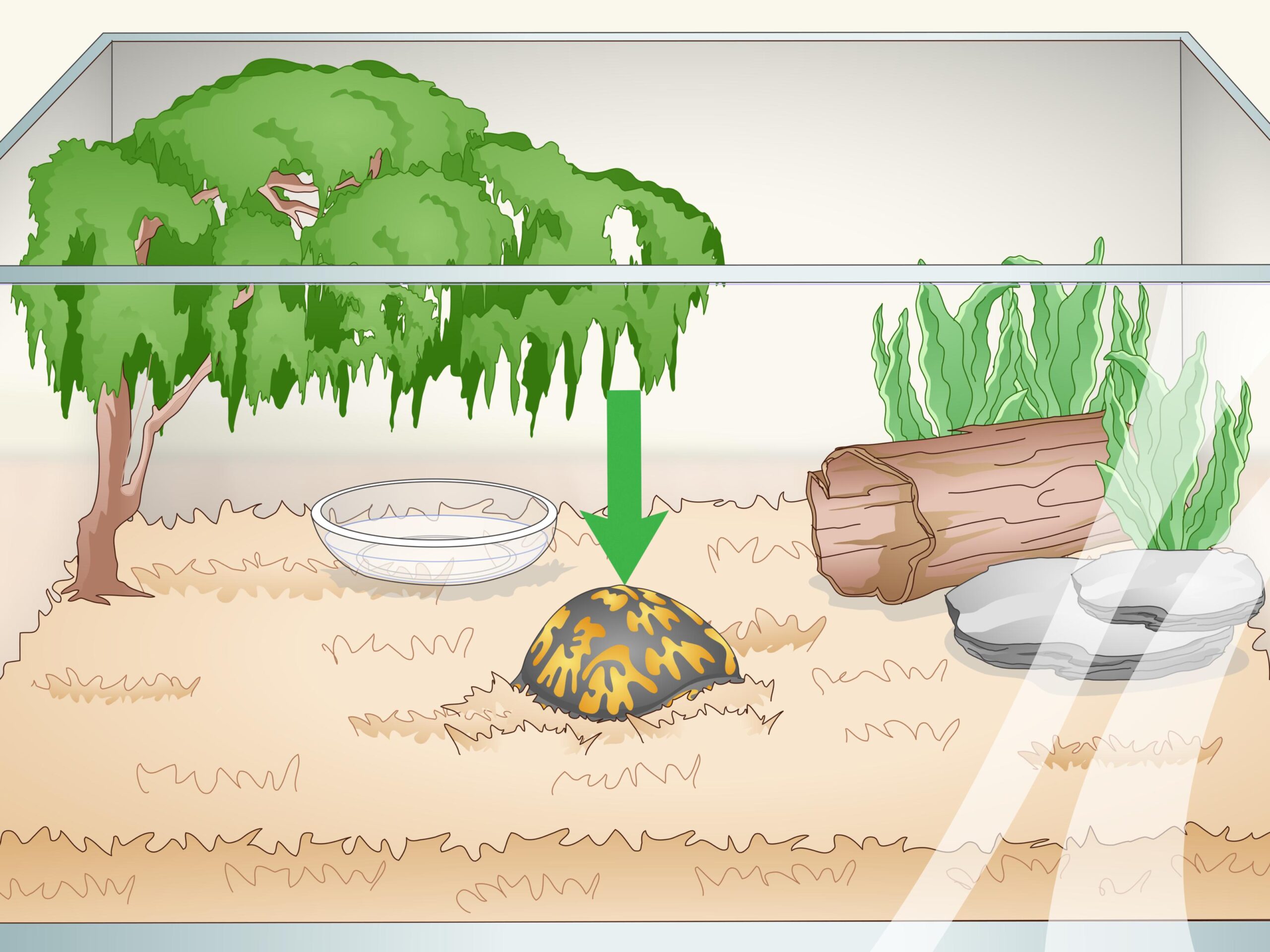To care for an Eastern Box Turtle, provide a secure outdoor enclosure and a varied diet. Eastern Box Turtles also require regular access to water for drinking and soaking.
Eastern Box Turtles are fascinating reptiles that make popular pets due to their unique appearance and behavior. In this guide, we will explore the essential aspects of caring for Eastern Box Turtles to ensure they thrive in captivity. By understanding their habitat needs, dietary requirements, and general care tips, you can create a healthy and enriching environment for these captivating creatures.
With proper care and attention, Eastern Box Turtles can live long, happy lives as cherished members of your family. Let’s delve into the world of Eastern Box Turtle care and discover how to provide the best possible care for these amazing reptiles.
Habitat Setup
For Eastern box turtles, create a habitat with a mix of soil, sand, and leaf litter. Add hiding spots, water dishes, and a basking area with UVB lighting. Maintain proper humidity and temperature levels to ensure the turtle’s well-being. Regularly clean the habitat to prevent infections and maintain hygiene.
Eastern box turtles require a suitable habitat to thrive. Here’s how to set up their habitat for optimal care:Outdoor Enclosure
Ensure the outdoor enclosure is escape-proof and spacious with shaded areas for the turtle to hide. – Cover the enclosure with wire mesh to protect the turtle from predators. – Include plants and rocks for the turtle to explore and bask under. – Maintain a consistent temperature and humidity level in the enclosure.Indoor Enclosure
Create a comfortable indoor space for the box turtle when it’s not outside. – Provide a terrarium or aquarium with a secure lid. – Add a heat lamp for basking and a UVB light for proper calcium absorption. – Include substrate for burrowing and a shallow water dish for soaking. By setting up the perfect habitat, you can ensure your Eastern box turtle stays healthy and happy.
Credit: www.wikihow.com
Diet And Feeding
Proper diet and feeding are essential for the well-being of Eastern box turtles. By understanding their natural diet and following feeding guidelines, you can ensure that your pet remains healthy and happy.
Natural Diet
Eastern box turtles have a diverse natural diet consisting of both animal and plant matter. In the wild, they consume insects, earthworms, snails, slugs, fruits, berries, and leafy greens. This varied diet provides them with the necessary nutrients and hydration.
Feeding Guidelines
When feeding your Eastern box turtle in captivity, it is important to replicate their natural diet as closely as possible. Offer a balanced diet consisting of live insects such as crickets, mealworms, and earthworms, along with a variety of fruits and vegetables. Leafy greens like kale, collard greens, and dandelion greens should also be included in their diet.
Supplement their diet with calcium and vitamin D3 to ensure proper bone health. Avoid feeding them foods high in fat, sugar, or protein, as these can lead to health issues. Offer fresh, clean water for drinking and soaking to maintain hydration.
Healthcare
Discover effective ways to care for Eastern Box Turtles to ensure their health and well-being. Providing a balanced diet, suitable habitat, and regular veterinary check-ups are essential for their longevity and happiness. Taking proactive steps in their care can lead to a thriving and contented turtle companion.
Taking care of an Eastern Box Turtle involves a lot of responsibilities, and one of the essential aspects of pet care is healthcare. Proper healthcare involves preventing common health issues, providing veterinary care, and ensuring that your pet turtle is in good health. In this section, we will discuss the importance of healthcare, common health issues, and veterinary care to keep your Eastern Box Turtle healthy and happy.Common Health Issues
Eastern Box Turtles are generally healthy pets, but they are susceptible to some health issues. Understanding the common health issues can help you prevent them and keep your pet turtle healthy. Some common health issues that Eastern Box Turtles may experience include:- Respiratory infections
- Shell infections
- Parasites
- Vitamin A deficiency
- Metabolic bone disease
Veterinary Care
Regular visits to a qualified reptile veterinarian are essential to ensure the optimal health of your Eastern Box Turtle. A veterinarian can examine your pet turtle and detect any underlying health issues that may not be visible to the naked eye. During the visit, the veterinarian may perform a physical examination, fecal examination, blood work, and X-rays to ensure that your pet turtle is in good health. It is recommended to take your pet turtle for a veterinary check-up at least once a year or as advised by the veterinarian. If you notice any unusual behavior or symptoms in your pet turtle, such as lethargy, lack of appetite, or abnormal growth, you should immediately consult a veterinarian. In conclusion, providing proper healthcare to your Eastern Box Turtle is crucial to ensure that your pet turtle is healthy and happy. Preventing common health issues, providing veterinary care, and maintaining optimal living conditions are essential aspects of healthcare. By following these tips, you can ensure that your pet turtle lives a long and healthy life.Handling And Interaction
When it comes to caring for Eastern box turtles, proper handling and interaction are crucial aspects of their well-being. It’s essential to understand the correct techniques for handling these unique creatures and creating enriching interactions to ensure their health and happiness.
Proper Handling Techniques
Box turtles are sensitive to handling and can become stressed if not done properly. When picking up a box turtle, gently scoop it up from underneath, supporting its body and shell. Avoid grabbing or squeezing the turtle, as this can cause distress and injury. It’s important to handle them with care and respect their natural behaviors.
Creating Enriching Interactions
Interacting with Eastern box turtles can be a rewarding experience for both the turtle and the caregiver. Provide a stimulating environment with diverse textures, hiding spots, and natural elements to encourage natural behaviors. Introduce safe objects for them to explore and interact with, such as non-toxic plants, branches, and natural substrates.
Reproduction
Reproduction is a crucial aspect of the Eastern Box Turtle’s life cycle. Understanding their mating behavior and egg incubation process is essential for their conservation and well-being.
Mating Behavior
Eastern Box Turtles typically reach sexual maturity between 7 to 10 years of age. During the mating season, which usually occurs in the spring and early summer, males actively pursue females. Males display courtship behaviors such as head bobbing and circling the female, often accompanied by vocalizations. Once the male successfully mates with a female, she may store the sperm for several years, using it to fertilize multiple clutches of eggs.
Egg Incubation
After mating, the female Eastern Box Turtle seeks out a suitable nesting site, which is often in well-drained, sandy soil. She then excavates a shallow nest, typically 2 to 4 inches deep, and lays a clutch of 3 to 8 eggs. The incubation period varies depending on environmental conditions, with eggs typically hatching after 60 to 90 days. The sex of the hatchlings is determined by the incubation temperature, with higher temperatures resulting in more females and cooler temperatures producing more males.
:strip_icc()/box-turtles-as-pets-1237255-FINAL-5b9bcdb04cedfd00506dc033.png)
Credit: www.thesprucepets.com
Conservation Efforts
To care for Eastern Box Turtles, it’s important to focus on conservation efforts. Protect their natural habitat, avoid capturing them as pets, and help reduce threats such as habitat loss and road mortality. Supporting organizations and educating others about conservation is crucial for their long-term survival.
Eastern Box Turtles are fascinating creatures that have been a part of the American landscape for centuries. However, due to habitat loss and other human activities, these turtles have been facing several challenges. Conservation efforts are being made to protect these turtles and ensure their survival. In this section, we will discuss the challenges faced by Eastern Box Turtles and ways to contribute to their conservation efforts.Challenges Faced
Eastern Box Turtles have been facing several challenges that are threatening their survival. Some of the significant challenges faced by these turtles are:- Habitat loss due to urbanization and agriculture
- Predation by domestic animals and other predators
- Illegal collection for pet trade
- Environmental pollution
- Climate change
Ways To Contribute
There are many ways to contribute to the conservation efforts of Eastern Box Turtles. Some of the ways are:- Creating awareness: Educate people about the importance of Eastern Box Turtles and their conservation efforts. This can be done through social media, presentations, and educational programs.
- Reporting: Report any sightings of Eastern Box Turtles to the local authorities or conservation organizations. This will help in monitoring their population and distribution.
- Volunteering: Volunteer for conservation organizations that work towards the protection of Eastern Box Turtles. This can involve habitat restoration, monitoring, and research.
- Donating: Donate to conservation organizations working towards the protection of Eastern Box Turtles. This will help in funding their conservation efforts.
- Conserving habitat: Protect and conserve the habitat of Eastern Box Turtles by supporting land conservation efforts and reducing your carbon footprint.

Credit: reptilesmagazine.com
Conclusion
In caring for your Eastern Box Turtle, prioritize their habitat, diet, and health needs. By creating a suitable environment and providing proper nutrition, you can ensure their well-being. Remember, regular veterinary check-ups and attentive care are key to keeping your turtle happy and healthy for years to come.





Leave a Reply